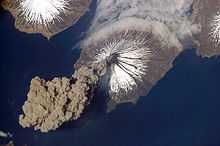Extreme environment
An extreme environment are conditions that are hard to survive for most life forms. These may be extremely high or low ranges of temperature, radiation, pressure, acidity, alkalinity, air, water, salt, sugar, carbon dioxide, sulphur, petroleum and many others.
Some examples of extreme environment are rock pools, desert, high mountains and others.
An extreme environment is one place where humans generally do not live or could die there. There are organisms referred to as extremophiles, that inhabit these spaces and are so well-adapted that they readily grow and multiply.
Examples of extreme environments include the geographical poles, very dry deserts, volcanoes, deep ocean trenches, upper atmosphere, Mt Everest, outer space and some other planets. The organisms living in these conditions are often very well adapted to their living circumstances, which is usually a result of long-term evolution.
Types of Extreme Environments are alkaline, acidic,extremely cold, extremely hot, hyper-saline, places without water or oxygen, and places altered by humans. Examples of places altered by humans are mine talings or oil impacted habitats. [1] [2] Before humans were around there were extreme environments covering our planet everywhere. Most of the moons and planets in our solar system are also extreme environments. Scientists have found life in these environments and have started to learn new things about earth's history.[2]
Picture gallery
-

Atmosphere and Universe
-

High salinity of the Dead Sea
Types of Extreme Environment
Alkaline: broadly conceived as natural habitats above pH 9 whether persistently, or with regular frequency or for protracted periods of time.
Acidic: broadly conceived as natural habitats below pH 5 whether persistently, or with regular frequency or for protracted periods of time.
Extremely Cold: broadly conceived habitats periodically or consistently below -17°C either persistently, or with regular frequency or for protracted periods of time. Includes montane sites, polar sites, and deep ocean habitats.
Extremely Hot: broadly conceived habitats periodically or consistently in excess of 40°C either persistently, or with regular frequency or for protracted periods of time. Includes sites with geological thermal influences such as Yellowstone and comparable locations worldwide or deep-sea vents.
Hypersaline: (high salt) environments with salt concentrations greater than that of seawater, that is, >3.5%. Includes salt lakes. Under Pressure: broadly conceived as habitats under extreme hydrostatic pressure—i.e. aquatic habitats deeper than 2000 meters and enclosed habitats under pressure. Includes habitats in oceans and deep lakes.
Radiation: broadly conceived as habitats exposed to abnormally high radiation or of radiation outside the normal range of light. Includes habitats exposed to high UV and IR radiation.
Without Water: broadly conceived as habitats without free water whether persistently, or with regular frequency or for protracted periods of time. Includes hot and cold desert environments, and some endolithic habitats.
Without Oxygen: broadly conceived as habitats without free oxygen - whether persistently, or with regular frequency, or for protracted periods of time. Includes habitats in deeper sediments.
Altered by Humans: heavy metals, organic compounds; anthropogenically impacted habitats. Includes mine talings, oil impacted habitats.
Astrobiology: Addresses life beyond the known biosphere—inclusive of life on other heavenly bodies, in space etc. Includes terraforming.
See also
- Adaptation
- Ecology
- Extreme environment clothing
- Extremophile
- LExEN (Life in Extreme Environments)
- Natural environment
References
"Extreme Environment." Microbial Life. N.p., n.d. Web. 16 May 2013.
- ↑ "Types of Extreme Environments". NSF. Retrieved 16 May 2013.
- ↑ 2.0 2.1 "Extreme Environments". PeckHart Landscaping inc. Retrieved 17 May 2013.



